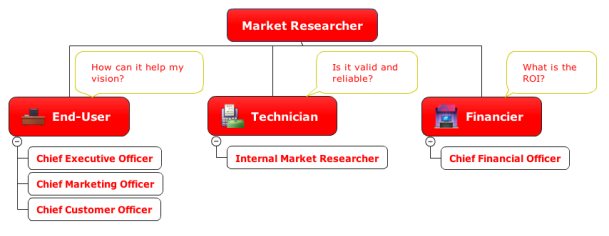As a market researcher, one major and important job is to deliver research results and corresponding recommendations to the clients. It includes both written and oral communication: writing research reports and giving final presentation. After you did all the background research, sampling, interview, data analysis, etc., now is the time to show your clients what you found. In my opinion, whether you can succeed in this final step highly depend on how much do you know about your “audience”.
Obviously, the audience is your client. No matter what kind of research you do or what problems you are asked to solve, there are three typical types of people who will review and use your deliverables from the client side. I call them “End-user”, “Technician” and “Financer”.
As shown in the diagram, these 3 types of audience are different in their roles and expertise. Therefore, their focuses on market researchers’ presentation are also distinct. Regularly, these 3 types of audience won’t be all shown up in a presentation, but sometimes they do attend the meeting together. So, the question is how a market researcher can satisfy all 3 kinds of audience in a single presentation?
The End-Users: They are usually from C-suite, like the CEOs, CMOs, or CCOs (Chief Customer Officer). They are super busy and have a lot of things in mind when digesting the messages from the presentation. Sometimes, they might join the presentation after the researcher has talked for a while, which made the situation even more challenging. However, what they expect from the presentation can be simply generalized into one question: “How can it help my vision?” They care more about the key findings and the interpretations than the data source and research process. So, make sure these key messages appear several times in the presentation, at least at the beginning as a executive summary and at the end as a summary. If they miss those information at the beginning, they still have chance to know it somewhere else.
The Technicians: They are usually the in-house market researchers or research staff from PR/Advertising agencies that also work with your client. I call them “technicians” because they can do research by themselves, which means they know all the skills and techniques about sampling, research design, data analysis, etc. They are at the presentation to check and “question” your methodology. Therefore, we should make sure we prepare the information that they want. However, we may not explain it a lot in the presentation, especially when the “end-users” are also in the meeting. The preparation I mentioned include two things: a comprehensive research report and the anticipation of research-method-related questions in the Q&A session after the presentation. Before you start presenting, you can explain that due to the time limit, the details of research process won’t be include in the presentation, but if the audience want to know more about it, they can get the information from the comprehensive research report or ask you in the Q&A session.
The Financiers: They are usually the CFOs or account managers from the PR/Advertising agencies that also work for your client. The only thing they care about in the presentation is how feasible the research findings and recommendations from finance viewpoint. In other words, what are the ROIs for the marketing strategies you suggest according to your research findings? If it is a presentation for request for proposal (RFP), then you need to show the total budget for the research and the breakdowns.
If you take into account the distinct demands of the 3 types of audience in mind when giving the presentation, you are halfway to success! Hope this post is helpful to you and I’m more than happy to hear your opinion!


